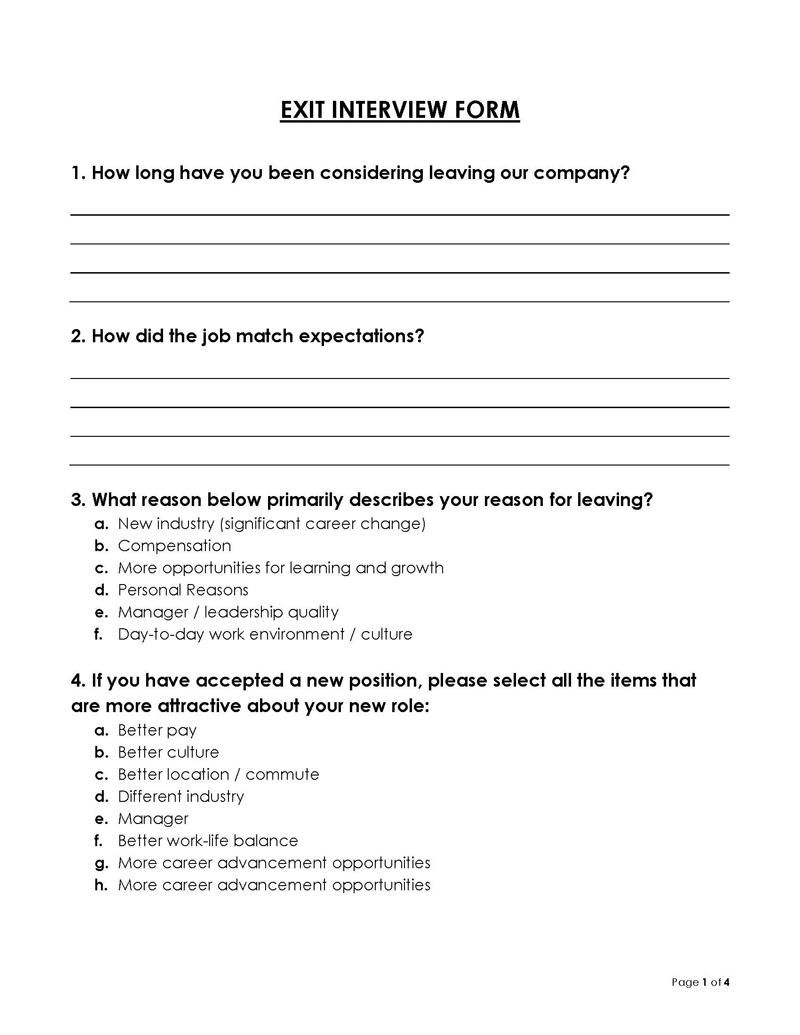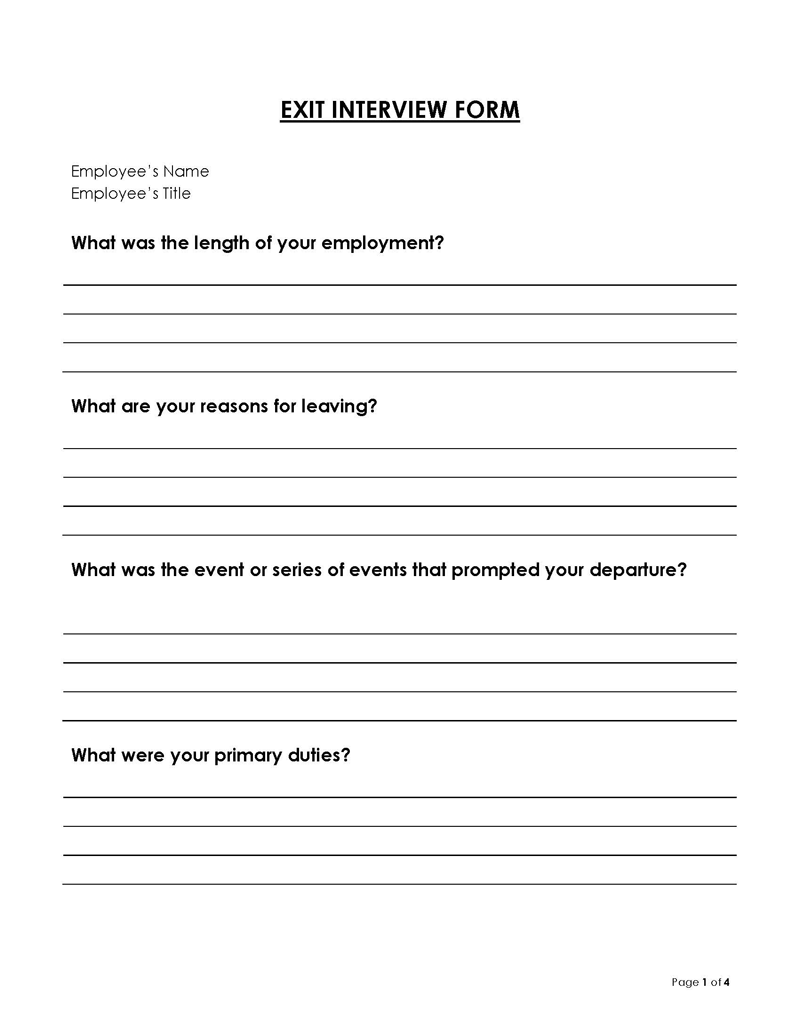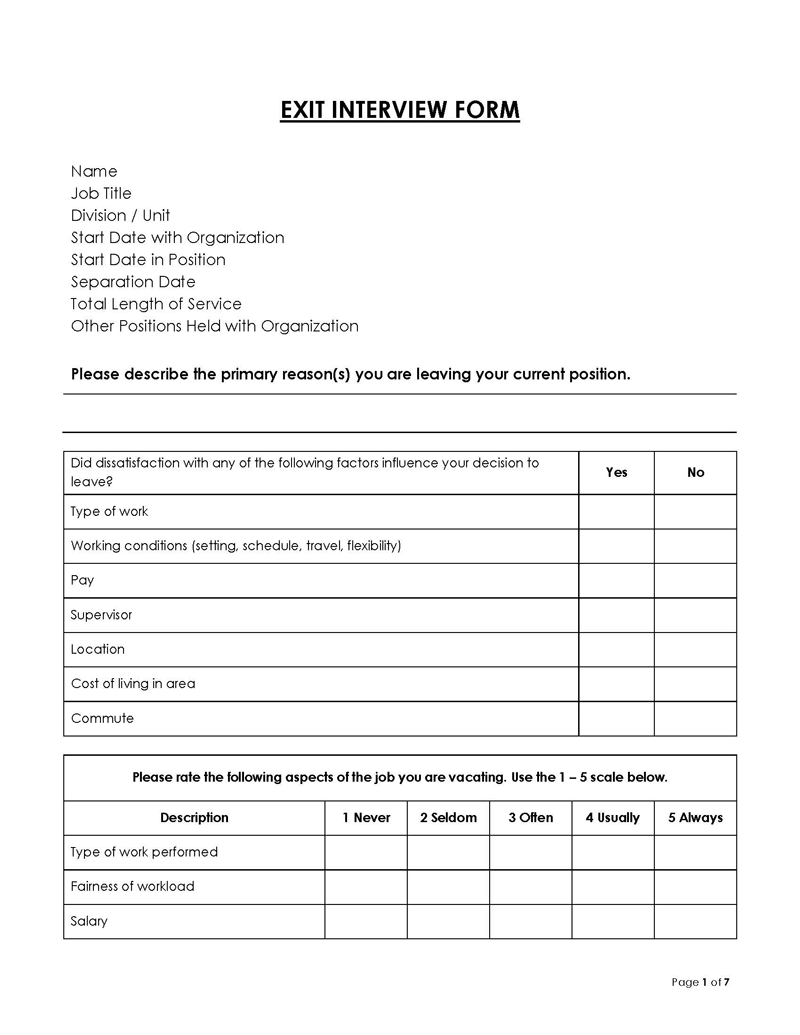An exit interview is a type of interview given to an employee who is leaving a company.
They are typically completed when an employee leaves a company either through a layoff or by choice. The exiting employee is asked to participate in the interview process by providing their opinion on various topics, such as performance review, degree of satisfaction concerning compensation and benefits, areas for improvement, and suggestions for improving things within the company.
A template is usually used when conducting such interviews to ensure the process is consistent, thorough, time-saving and that no important area is left out when interviewing exiting employees. The information obtained in the interview is usually used to help you, as an employer, understand how you should treat your employees to attract better quality applicants and retain current valued employees who could potentially leave the company.
Why You Should Use an Exit Interview
Exit interviews are usually conducted by human resource professionals or managers who want to know more about why the employee is leaving, how they feel treated by the company, and what they will say about the company when they leave.
The purpose of the interview is to simply assess the employee’s level of satisfaction with their company, manager, and co-workers; to obtain any relevant comments they may make regarding the company that they might not want to share in public; and to learn the reasons why they are leaving. This helps the organization improve the quality of service.
It also helps employees by giving them a chance to voice any concerns before leaving. With the issues that were brought forward in the process.
What is an Exit Interview Form?
An interview form is a document designed for managers to conduct exit interviews. The form is usually given to the employee by their employer. It ensures that you as an employer get the most accurate information possible on the employee’s reason for leaving, how they feel about their job, their perspective on the company’s culture, work environment, and their thoughts and suggestions on improving things in the future.
The forms also give exiting employees a chance to comment on various areas relating to their job and company and express any concerns they may have had while they were working for the company. This information is collected from employees who are leaving in order to determine if there are any issues that need to be addressed and corrected.
Free Templates



What to Include
The interview form should have various sections, with each section covering one aspect of the interview. The sections should be arranged in a logical manner and should cover all the areas that are most important to you and your company.
Some of the most important sections that should be included in any interview form include:
Feedback on employee-manager relationship
The first section of the interview form should include feedback employees have about their relationship with the manager. This feedback should include a discussion of how the managers treated them, how their managers handled the day-to-day situations in which they were involved, what role their managers played in the company, whether or not they felt that the employees were respected by their managers.
Questions pertaining to this topic could include:
- Did you feel that your supervisor showed a genuine interest in your development and personal growth as an employee?
- Would you say that you were treated fairly by your employer?
- Were you satisfied with the feedback that you were given during your performance evaluations?
- Did you feel like you had a good relationship with those who worked under you at times when they asked for help or guidance?
Reasons for leaving
The second section of the interview form should include the reasons why the employee is leaving your company. The reasons for leaving may be personal such as health, better opportunities, etc., or job-related, which may include things to do with the salary, benefits, working hours, co-workers, and the company’s culture.
Questions pertaining to this section may include:
- What prompted you to look for other opportunities?
- Are you leaving for a better position or because of dissatisfaction?
- What are some of the problems that you faced during your employment with this company?
Missing perks, benefits, and opportunities
The third section of the interview form should include any missing opportunities, benefits, or perks that were offered. This will allow you, as an employer, to determine if any benefits or perks were omitted or should be introduced to improve the employee’s opinion of the company.
Some of the questions that may be included in this section include:
- What perks did you feel were missing from your benefits package?
- Are there any benefits that you think would have made your job easier or more enjoyable?
The perspective of the company culture
The fourth section of the interview form should include the employee’s perspective of your company’s culture. This will give you an idea if there is any room for improvement in their current culture.
Some of the questions that can be asked in this section may include:
- How would you describe the company’s culture?
- Would you say that the company has a good reputation? If so, why? If not, why?
- What would you say are some of the things that employees like most about working for this company?
View of the work environment
The next item that should be included in the interview form is the employee’s perspective on their work environment. It is important to understand if there are any problems with the physical working conditions, such as the number of people in the office, temperature, and noise levels.
Understanding the employee’s perspective of their working environment will help you to determine if any changes need to be made in order to improve the working environment and if they need additional office space or equipment.
Some of the questions that may be asked in this section include:
- Would you say that the number of co-workers working at the company contributed to a good or bad working environment?
- Would you say that the area in which you worked was well-lit and had good air circulation?
- Is there anything that you were not happy with when it comes to the facilities and equipment offered by the company?
Feedback about the available technology tools and resources
The next section in the interview form should focus on any feedback the employee may have about available technology tools and resources. This information can help you and your manager determine if you are offering enough resources to your employees and if there are any technological breakdowns in the office that you should focus on.
Some of the questions that may be included in this section include:
- What technologies and tools would you say are available to you?
- Would you say that the company provided enough technology resources for your work and personal needs?
How employees feel about them now vs. when they started
Another important section in the interview form is how the employees feel about your company, managers, and co-workers now versus when they started with the company. This section may reveal employee dissatisfaction or unhappiness that has festered for some time. You, as an employer, should be aware of these issues to be able to address any problems before they become worse.
Some of the questions that could be asked in this section include:
- Was the working environment at first satisfactory?
- Did you enjoy your co-workers during your first few months with the company?
- How would you rate your management style as a supervisor now compared to when you started working?
How to Use Data from Exit Interviews
The information collected from the interview will help you evaluate your company and identify areas of improvement that can be made in order to keep employees happy. By having these interviews throughout your organization, you can also implement new policies and procedures that will help encourage employee retention and increase productivity within your company. In addition, gaining a better understanding of employees at all levels exiting the company is crucial to ensuring your company has a productive work environment.
However, it is not always easy to look at the data from these interviews and identify areas that need improvement. Using best practices for conducting interviews, such as an effective interview form, and then analyzing the data will ensure that the data you are looking at is as helpful as possible.
Frequently Asked Questions
The interview questionnaire aims to collect information from exiting employees. Once the information has been collected, the data will be used to identify any issues that may have contributed to or caused employee dissatisfaction.
Every employee exiting the company should fill out the interview form. This can be a voluntary or mandatory process depending on what you as an employer would like to accomplish by using this form.
The interview process involves the interviewer conducting a series of interviews with the exiting employees to obtain information on various topics that will be kept private. The interviewer should cover everything from the employee’s attitude towards their job and company to their future plans, giving special attention to what is and isn’t said.




